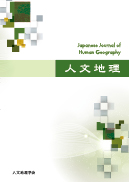
- Issue 4 Pages 371-
- Issue 3 Pages 221-
- Issue 2 Pages 127-
- Issue 1 Pages 1-
- |<
- <
- 1
- >
- >|
-
Taiyo Yagasaki2019Volume 71Issue 4 Pages 371-392
Published: 2019
Released on J-STAGE: February 15, 2020
JOURNAL FREE ACCESSThe Great East Japan Earthquake in March 2011 caused a tsunami that resulted in a horrific disaster on the Sanriku coast of northeast Japan. Devastated locals witnessed the decrease in population and community reorganization during the process of reconstruction. By examining the coastal communities of Kesennuma City’s Urashima District, this paper attempts to explain the reorganization of local communities and the response to the decreasing population by applying the concept of resilience. Local communities reorganize themselves by exercising their resilience, the response to which depend on the regional characteristics formed prior to the disaster. One of the four settlements of Urashima that had experienced major tsunami damage in the past was able to minimize casualties as houses had already been relocated to higher ground. Each of the other three settlements implemented collective relocation projects to higher ground based upon traditional community organizations. The relationships formed in the entire district of Urashima beyond the settlements’ boundaries facilitated the exchange of information among residents, and contributed to the promotion of the reconstruction process. The Urashima Promotion Association has also been gaining importance as a center for wider community activities. As many residents moved to other residential areas in Kesennuma City, support associations were set up to sustain ties with outbound migrants and maintain the traditional community relationship. Thus, devastated local communities have been reorganized into a form that will be resistant to future disasters and the decreased population.
View full abstractDownload PDF (2947K) -
Kazumi Sato2019Volume 71Issue 4 Pages 393-416
Published: 2019
Released on J-STAGE: February 15, 2020
JOURNAL FREE ACCESSReferring to a ‘performativity of scale’ approach, this article aims to describe the way in which scales, as discursive practices, produced substantial effects during the construction process and utilization of the Grand Mosque of Strasbourg, in France. This mosque was established in 2012 by taking advantage of Alsace-Moselle local law allowing religious communities to obtain public financial aid, while located in France, the very soil of laïcité. Based on the constructionist perspective of ‘scale’ developed in human geography, I attempted to analyze, by quoting interview records, how scalar discourses influenced the process of the construction and the material aspects of this mosque, and how scalar discourses were reconstructed throughout utilization of the mosque. The analysis showed that various scales were linked to the distinction of here / elsewhere, and that their borders were continuously contested in the discursive practices of scale.
View full abstractDownload PDF (1396K) -
Chunying Nan2019Volume 71Issue 4 Pages 417-437
Published: 2019
Released on J-STAGE: February 15, 2020
JOURNAL FREE ACCESSThis paper aims to clarify the features of the descriptions of Japan in Chinese geography textbooks. Japan and China share a long-term relationship. The descriptions of Japan in Chinese middle school geography textbooks are likely to be closely related to changes in the social backgrounds. This paper will explore these social backgrounds along with the transformation of the descriptions of Japan in Chinese middle school geography textbooks. I analyzed the quantitative and qualitative descriptions of Japan in Chinese middle school geography textbooks that were used from 1949 to 2019. According to the quantitative and qualitative characteristics, the changes in the descriptions of Japan in Chinese middle school geography textbooks can be divided into the following three stages. The period from 1949–77 was one of political changes reflecting the international situation, 1978–2007 was a period of economic changes reflecting the reform and opening up and the socialist market economy, and 2008–2019 reflected the cultivation of sense of closeness with Japan and the restraint of the Japanese economy in Japan and Chinese relations. Through this analysis, we know that the description of Japan in Chinese geography textbooks is susceptible to political influence. In other words, the government has a strong control over education.
View full abstractDownload PDF (1040K)
-
[in Japanese]2019Volume 71Issue 4 Pages 438-439
Published: 2019
Released on J-STAGE: February 15, 2020
JOURNAL FREE ACCESSDownload PDF (632K) -
[in Japanese]2019Volume 71Issue 4 Pages 440-441
Published: 2019
Released on J-STAGE: February 15, 2020
JOURNAL FREE ACCESSDownload PDF (630K)
-
2019Volume 71Issue 4 Pages 442-481
Published: 2019
Released on J-STAGE: February 15, 2020
JOURNAL FREE ACCESSDownload PDF (843K)
- |<
- <
- 1
- >
- >|